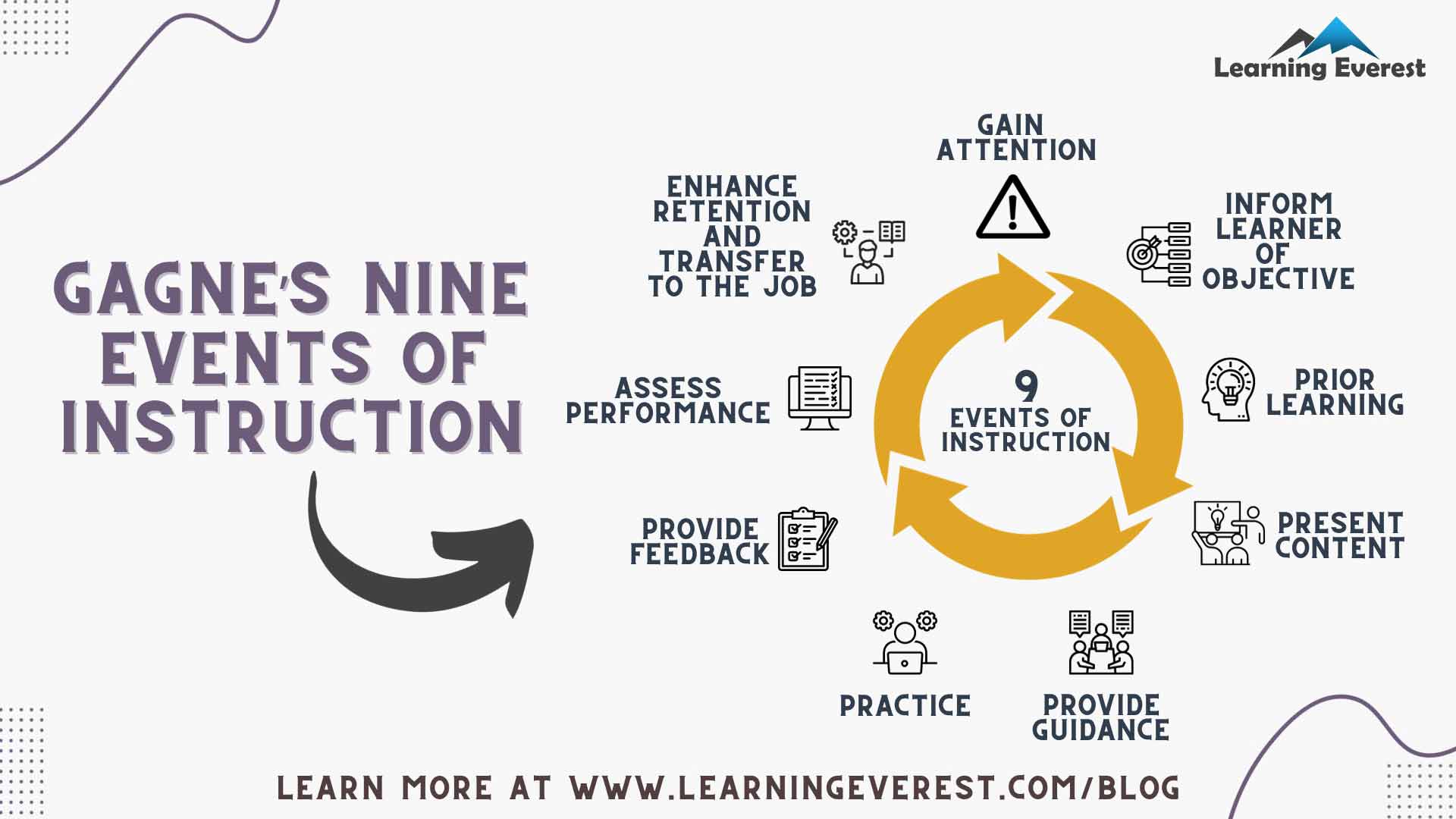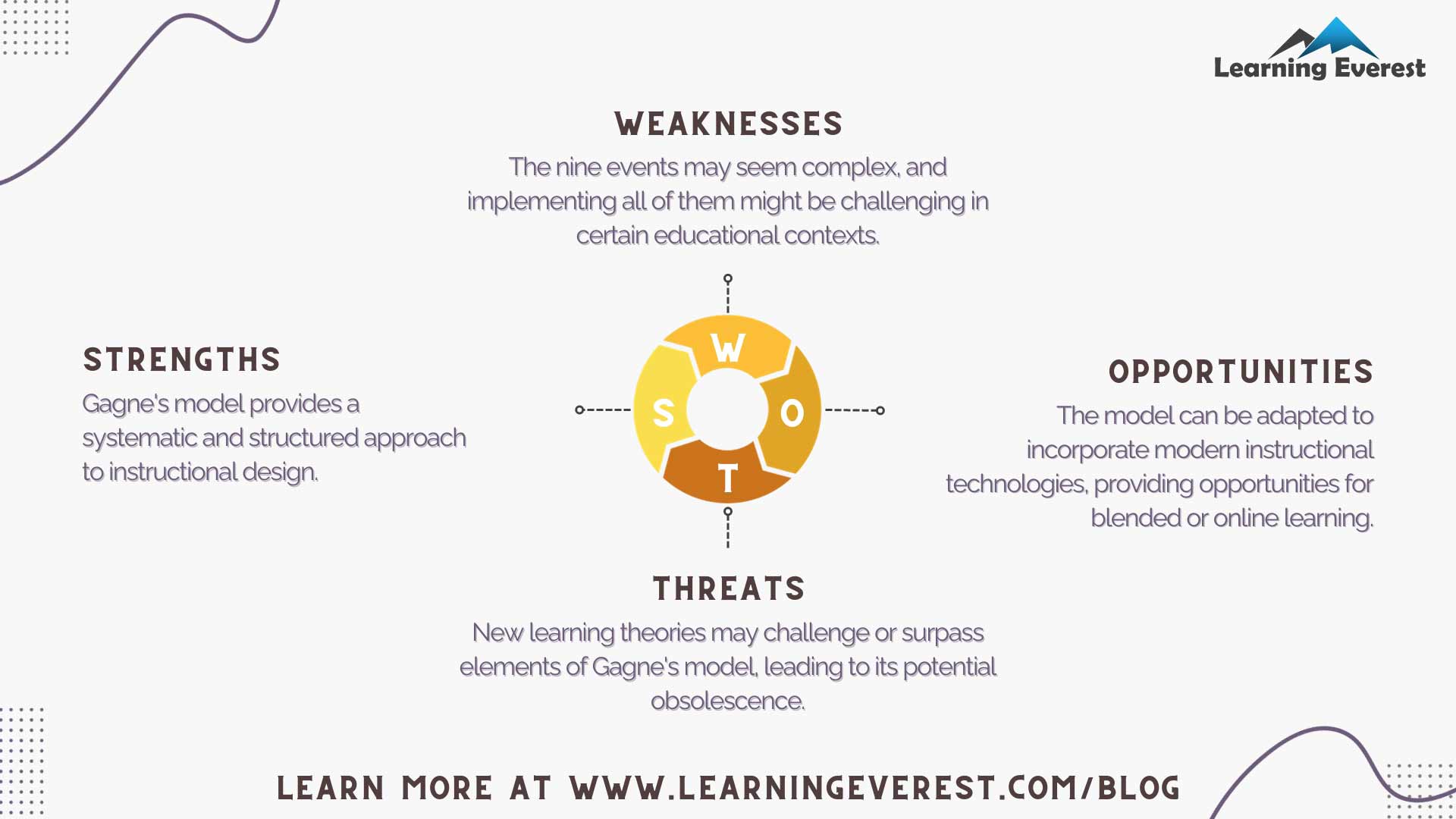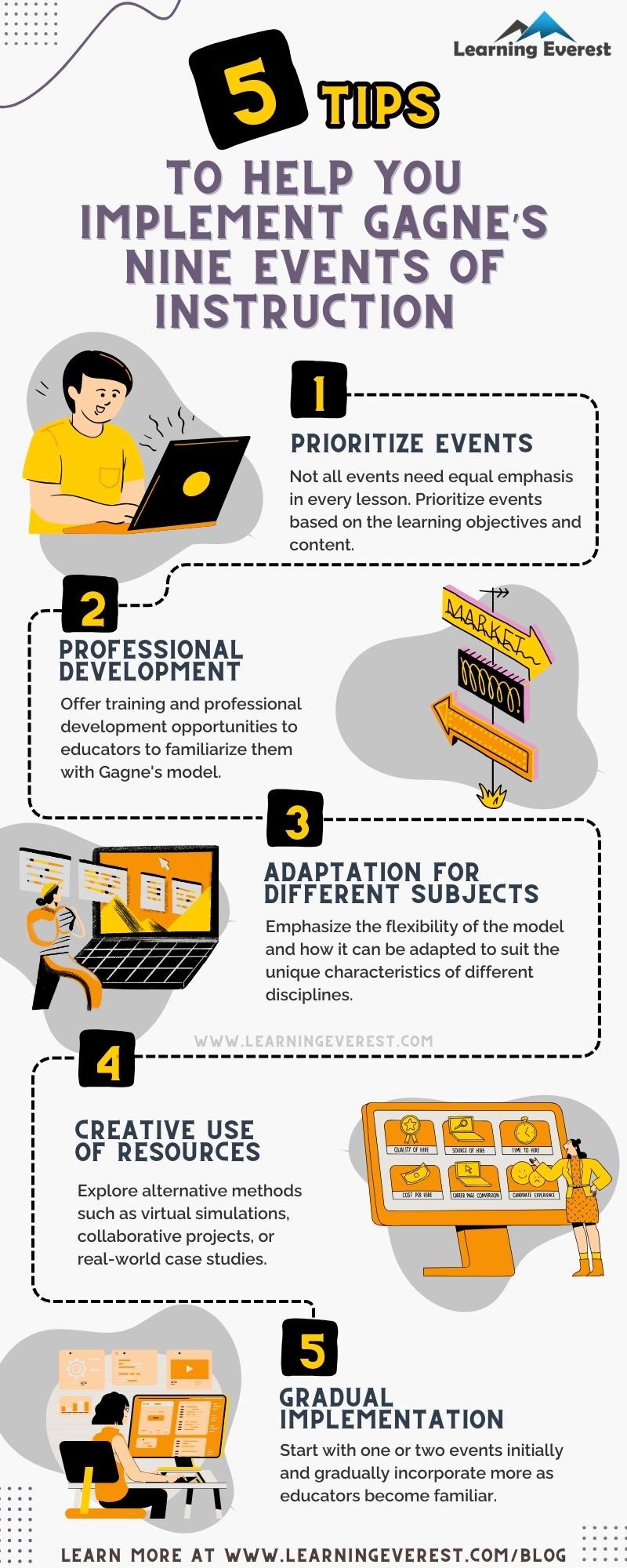Developed by Robert Gagne, this model provides a sound framework that is widely used today and is commonly known as Gagne’s Nine Events of Instruction. Gagne did significant research about the learning process during World War II and developed this model in 1965. In an article titled, ‘Educational Technology and the Learning Process’ (Educational Researcher, 1974), Gagne defined instruction as ‘the set of planned external events which influence the process of learning and thus promote learning.’ In addition to Gagne’s Nine Events of Instruction, there are other models of Instructional Design like ADDIE model and Merrill’s First Principles of Instruction.
Table of Contents
- Gagne’s Nine Events of Instruction: Explained
- Advantages of Gagne’s Nine Events of Instruction:
- Disadvantages of Gagne’s Nine Events of Instruction:
- Infographic
- Knowledge Check!
- Frequently Asked Questions (FAQs)
- What is the Gagne’s framework?
- What are the 9 events of Instruction according to Gagne?
- What are the advantages of Gagne’s nine events of instruction?
- What are the disadvantages of Gagne’s nine events of instruction?
The Nine Events of Instruction form a framework for the learning process. Let us understand them in detail.

Gagne’s Nine Events of Instruction
Gagne’s Nine Events of Instruction: Explained
1. Gain attention:
Ensuring that the learners are ready to learn and are motivated to encounter something new is essential, according to Gagne. This can be done by presenting an innovative and exciting stimulus, posing thought-provoking questions, or even an activity that serves as an icebreaker is useful. The cognitive process involved here is reception. You can gain attention by playing a game, telling a joke, asking the learners some thought-provoking questions, narrating a story, or by conducting an ice-breaking activity.
2. Inform the learners of the objectives:
The learners must be informed of the course’s aims, goals, and learning outcomes. There could be a demonstration to enlighten the learners about the skills and knowledge of the course. The cognitive process here is expectancy. You can describe to the learners what they will learn and its importance. Another way is to explain the criteria for standard performance so that the learners know what to expect.
3. Stimulate recall of prior learning:
It is essential to remind learners of the prior knowledge relevant to the course. This helps in making meaningful connections with what is being presented to them. The cognitive process here is retrieval. You can ask questions from the previous modules, post questions for discussion related to prior knowledge of the learners, conduct quizzes, and conduct pre-test to understand what the audience already knows.
4. Present stimulus material to be learned:
This can be done using various media and incorporating information chunking. Demonstrations and activities can be used to make the content more meaningful and so that the learner can connect to the content. The cognitive process involved here is selective perception. You can ask the learners to write down notes, assign activities or projects, watch videos and perform lectures.
5. Provide learner guidance:
Examples can be provided to the learners and various tips and tricks. Images, videos, case studies can be included to facilitate connection with the new concepts. Semantic encoding is the cognitive process involved here. This also involves giving the learners tips on navigating through the course and writing all the instructions in clear and concise language to avoid ambiguity.
6. Elicit performance:
The learners can apply what they have learned by including several activities appropriate to the learning content. The cognitive process here is the response. This can be done with knowledge checks, tests, and quizzes. Often group discussion works wonders. Another option is to assign projects and involve the learners in activities and role-plays.
7. Provide informative feedback:
Timely feedback is crucial to the learner. It could include feedback where the learner is shown the correctness of the response, provided with a step-by-step solution, or with information and suggestion to improve performance. The cognitive process here is reinforcement. Personalized feedback on written assignments and project proves to be useful in this case. Also, feedback must include positive as well as negative points. Another way is to take peer-evaluation assessments, which would broaden learner perspectives.
8. Assess performance:
This is to test if the lesson has been useful and the learner has achieved the learning outcome. The cognitive process here is retrieval. Various ways to do this is to create quizzes or short questions. However, knowledge should be assessed at regular intervals throughout the course.
9. Enhance retention and transfer:
Learners can be given more examples of similar problems or situations to connect with the real-world. Previous material can be brought back, and retention can be assessed to gain an insight into the learning that has occurred. Generalization is the cognitive process here. You can have interactive e-learning activities and allow for flexible learning opportunities that include real-world scenarios.
Gagne’s nine events of instruction can be modified, and each different stage complements the other.

Gagne’s Nine Events of Instruction
Advantages of Gagne’s Nine Events of Instruction:
Gagne’s Nine Events of Instruction are systematic and are simple to follow. Since they follow a logical order, learners feel confident in applying the steps and getting a return result. Furthermore, the theory can be adapted to suit different learning situations.
Disadvantages of Gagne’s Nine Events of Instruction:
However, a learner may require a lot of guidance when learning a new skill. It makes the learner dependent on guided information and may not explore the ways of problem-solving on his/her own based on the knowledge gained. Also, it takes a lot of time in the development phase as each step has to be planned, and an instructional designer may find better ways of keeping the students engaged in the learning process.
Infographic

5 Tips to Help You Implement Gagne’s Nine Events of Instruction
Knowledge Check!
Frequently Asked Questions (FAQs)
What is the Gagne’s framework?
Gagne’s framework is an instructional model developed by Robert Gagne model provides a sound framework that is widely used today and is commonly known as Gagne’s Nine Events of Instruction.
What are the 9 events of Instruction according to Gagne?
The nine events of instruction are to gain attention, inform the learners of the objectives, stimulate recall of prior learning, present stimulus material to be learned, provide learner guidance, elicit performance, provide informative feedback, assess performance, and enhance retention and transfer.
What are the advantages of Gagne’s nine events of instruction?
Gagne’s Nine Events of Instruction are systematic and simple to follow. Since they follow a logical order, learners feel confident in applying the steps and getting a return result. Furthermore, the theory can be adapted to suit different learning situations.
What are the disadvantages of Gagne’s nine events of instruction?
A learner may require a lot of guidance when learning a new skill. It makes the learner dependent on guided information and may not explore the ways of problem-solving on his/her own based on the knowledge gained. Also, it takes a lot of time in the development phase as each step has to be planned, and an instructional designer may find better ways of keeping the students engaged in the learning process.





